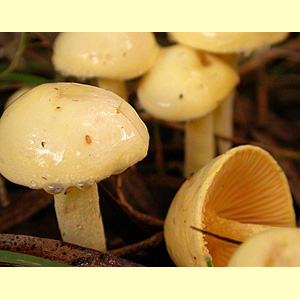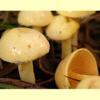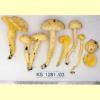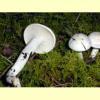
images/Hygrophorus_involutus/Hygrophorus_involutus_Denmark_WA_syme.jpg
Small to medium agaric, growing on the ground or bryophytes, with a white spore print. Pileus white, pale or yellow, viscid or glutinous. Lamellae adnate, subdecurrent or decurrent. Stipe central, attenuated downwards, and with droplets at apex. Partial veil remnants absent. Spores hyaline, non-amyloid, smooth; germ pore absent. Cheilocystidia absent. Lamellar trama bilateral. Pileipellis a trichoderm. Clamp connections present.
Clitocybe,
Lichenomphalia and
Rickenella can also have pale fruit-bodies with decurrent lamellae, but all lack the viscid pileus of
Hygrophorus involutus. Pale species of
Mycena usually grow on wood or litter. Other waxcaps (
Camarophyllopsis,
Humidicutis and
Hygrocybe) do not have bilateral lamellar trama, and a trichodermal pileipellis is only found in
Hygrocybe (and then not commonly). The bilateral structure of the lamellar trama can be difficult to see, and is more obvious in the upper part of the lamella. In
Limacella, which has bilateral trama, the spores are sometimes warty and/or dextrinoid, and there can be partial veil remnants.
Hygrophorus Fr., Fl. Scan. 339 (1836).
One species:
Hygrophorus involutus (including var.
albus). Australian records of other species of
Hygrophorus are doubtful, or they belong to
Humidicutis or
Hygrocybe.
Hygrophorus involutus G.Stev., Kew Bull. 16: 373 (1963).
W.A., S.A., Qld, N.S.W., Vic. and Tas. (and possibly also N.T.).
In native forests.
On the ground.
The genus is considered ectomycorrhizal. However, the trophic status of H. involutus is not yet determined.
Fuhrer, B. (2005),
A Field Guide to Australian Fungi. Bloomings Books, Hawthorn. [
Description and
Illustration of
H. involutus]
Fuhrer, B. & Robinson, R. (1992), Rainforest Fungi of Tasmania and South-east Australia. CSIRO Press, East Melbourne. [Illustration of H. involutus]
Horak, E. (1990), Monograph of the New Zealand Hygrophoraceae (Agaricales), New Zealand J. Bot. 28: 255–309. [Description, B&W Illustration and Microcharacters of H. involutus]
McCann, I.R. (2003), Australian Fungi Illustrated. Macdown Productions, Vermont. [Illustration of H. involutus, and white form as Hygrophorus sp., p. 33]
Young, A.M. (2001c), Profiles of fungi. 119. Hygrophorus involutus G. Stev., Mycologist 15: 36–37. [Description, Illustration and Microcharacters of H. involutus]
Young, A.M. & Mills, A.K. (2002), The Hygrophoraceae of Tasmania, Muelleria 16: 3–28. [Discussion of Tasmanian collections of H. involutus and Description of var. albus]
Young, A.M. & Wood, A.E. (1997), Studies on the Hygrophoraceae (Fungi, Homobasidiomycetes, Agaricales) of Australia, Austral. Syst. Bot. 10: 911–1030 [Description, B&W Illustration and Microcharacters of H. involutus]
Young, A.M. (2005a), Fungi of Australia: Hygrophoraceae, Australian Biological Resources Study, Canberra & CSIRO Publishing, Melbourne. [Description, Illustration and Microcharacters of H. involutus]
Young, A.M., Bougher, N.L. & Robinson, R.M. (2000), Hygrophoraceae of Western Australia II. Further taxa, Australas. Mycol. 19: 41–48. [Description, Illustration and Microcharacters of H. involutus]




